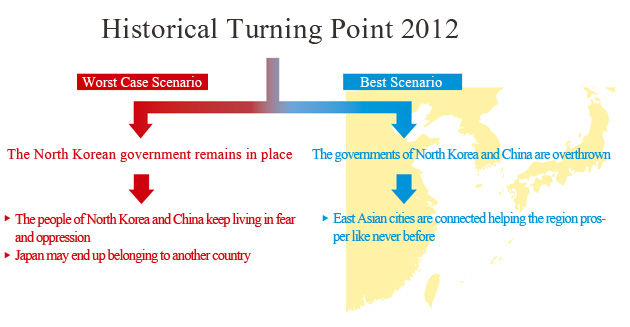Creating a Free & Prosperous East Asia for the 2020s
-Chief Editor’s Column, March 2012 Issue
From Korea’s unification to China’s destruction
If Japan, the U.S., South Korea, and the rest of the world made up their minds to deploy forces to North Korea and topple the government of Kim Jong-Un, the future could look completely different. Overthrowing the North Korean government might probably be easy and fast.
The more difficult issue is what would happen in China as a result of this.
If North and South Korea actually became one, the ethnic Koreans living in the North East of China would want to join them and start a big movement in this direction. Revolts would break out in China, seeking freedom and democracy. Of course the Chinese Communist party would try to clamp down on them, but the spark of these activities could easily catch on and motivate the independence movements of Hsinchiang Uighur, Tibet, and Inner Mongolia to join in, leading to the destruction of the “Chinese Empire. ”
This would mean a temporary return to the scattered rule of multiple war lords that raged in China between 1911 when the Chinese Revolution (Xinhai Revolution) overthrew the Qing dynasty, and 1949 when the People’s Republic of China was established. But in the long run, the enormous country of China would become a free, democratic state like present day Taiwan.

East Asia’s”traffic revolution”
If it came to this, East Asia would change drastically. The East China Sea, the Yellow Sea, and the Sea of Japan would become an inner sea like the Seto Inland Sea in Japan today, and large ferries could cross them. Today, we have a ferry connection between Fukuoka (Japan) and Busan (South Korea) that takes just under 3 hours, but we could have ferries going between all the different cities of Japan and Shanghai, Tianjin, Tsingtao and other Chinese ports.
Before China became Communist, there was a serious discussion about connecting Kyushu (Japan) with the Korean Peninsula through a tunnel under the sea, and building a railroad connecting Japan, the Korean Peninsula, and China, which could soon become a reality. A linear bullet train would take a little over 5 hours from Tokyo to Beijing. This is not very different from flying if you consider how long it takes to get to the airport.
“A traffic revolution” would occur in East Asia and enable people, things, money, and information to move freely. It would allow East Asia to flourish like it never has before, and place it at the forefront of economic development in the world.
We have a problem – What will we do?
Will East Asians live in fear and oppression like today, or will the world decide to free the region and help it prosper as 2020 draws near? We are standing at a crossroad in history.
The other option would be risking mass exodus, nuclear weapons moving along unknown paths, all-out war, and damage to the industry on the Korean Peninsula and the East Asian mainland.
In order to enable the poverty stricken people of North Korea, and the Chinese people robbed of freedom of expression and freedom of religion, to decide their own fate, the price has to be paid in one way or another.
This is why we are raising a question about the issue of overthrowing the North Korean government.
(Jiro Ayaori)


















